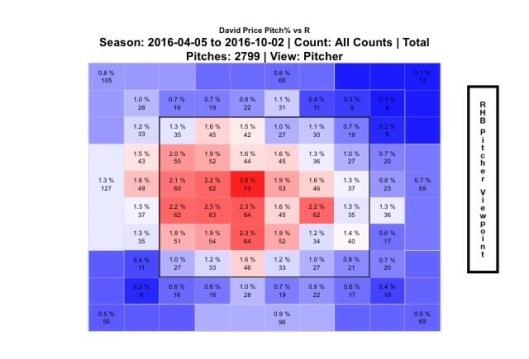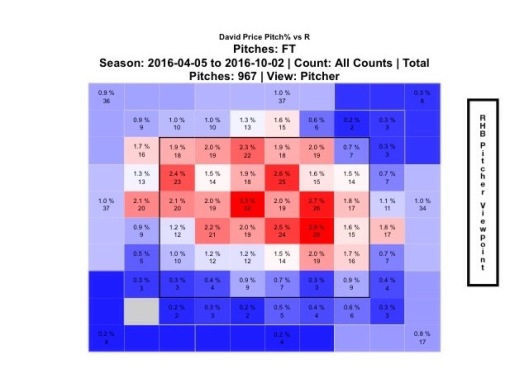Sigh of Relief Aside, Expect a Big Year From David Price
No matter what team you root for, we are all baseball fans, and as baseball fans, the game is better when David Price comes out of a visit with Dr. James Andrews in one piece. Red Sox fans held their collective breath after the (since-updated) report was released that Price was being sent to Dr. Andrews following a troubling MRI scan. Even Boston’s brass was expecting to lose Price for the year to Tommy John surgery. Of course, it is not known exactly what Price was diagnosed with, and being shut down for seven to ten days is still troubling, but while the spirits are up, let’s consider something else: David Price will be back in serious Cy Young contention this season.
To be clear, David Price was an excellent pitcher in 2016. Any team would sign up for a 4.5 fWAR pitcher, and that production alone is All-Star worthy. However, in the context of David Price’s career, 2016 qualified as an “off year.” His previous two seasons saw him post totals of 6 fWAR and 6.4 fWAR, respectively. Looking at traditional stats, his 3.99 ERA was his highest since his 128-inning rookie season. So while Price was worth every penny in 2016, it wasn’t the rosiest year of his career.
If we want to find out what was different for David Price in 2016, we won’t have to look very far.
What Went Wrong For David Price in 2016
| Year | HR/9 | FB% | HR/FB% | Pull% | Hard Hit% |
| 2010 | 0.65 | 39.6% | 6.5% | 30.1% | 25.5% |
| 2011 | 0.88 | 36.9% | 9.7% | 34.4% | 24.7% |
| 2012 | 0.68 | 27.0% | 10.5% | 35.3% | 25.6% |
| 2013 | 0.77 | 33.4% | 8.6% | 34.7% | 28.6% |
| 2014 | 0.91 | 38.1% | 9.7% | 36.4% | 28.3% |
| 2015 | 0.69 | 36.4% | 7.8% | 33.3% | 28.2% |
| 2016 | 1.17 | 33.9% | 13.5% | 44.1% | 34.8% |
*all stats via FanGraphs
Starting in column two, we can see a clear-cut spike in the number of home runs he allowed. Your first thought may be that this can be explained by his having to pitch in the notoriously hitter-friendly Fenway Park, but Price has pitched nearly his entire career in the confines of the American League East and hasn’t had a homer problem until this point. So we move to column two, with the hopes that an increased fly-ball percentage would be the answer to our question. However, his fly-ball percentage was actually his third-lowest recorded since 2010, which makes his spiked home-run-per-fly-ball percentage in column four even more puzzling. With the mystery unsolved, we move to the next column, which measures the percentage of balls in play that were pulled by opposing batters. This rate increased dramatically in 2016, and it coincides with the escalated hard-hit rate in column six.
If opposing batters (generally righties) are squaring up on the ball and pulling it more than ever (generally to the Green Monster) on Price, it stands to reason that he is giving them pitches to pull hard. Let’s first examine a heatmap from Price’s pitch locations to right-handed batters over the same six-year sample size we have been using.

*via FanGraphs
This looks pretty good! It’s no wonder why Price has been so adept at avoiding the longball; he really pounds the outside corner on those right-handed batters. So let’s look at 2016 and see if anything has changed.

*via FanGraphs
Yeah, that will change your fortunes. Much less of that outside corner action, much more of that “meatball right down the middle” action. I decided to dig a little deeper and look at which of his four pitches (fastball, cutter, changeup, and curve) was most responsible, or if multiple pitches were culprits. I’ll save you the trouble and get to the one culprit.

*via FanGraphs
We’ve got a match, and you probably guessed it – it’s the fastball. I can’t explain to you why Price was missing his spots, but you and I know that this is a game of inches, and his fastball was responsible for 16 of the 30 homers he gave up. While this is purely speculation, it’s possible that Price was getting acclimated to his new environment and $217M contract. Whatever the case may be, this is the only adjustment that he really has to make in 2017 to return to his previous levels of Cy Young stardom.
Pitching is an unforgiving occupation, and pitchers often spend years refining their craft, but I am willing to go out on a limb and bet that someone of David Price’s caliber can make this one readjustment. He is no longer the new big-ticket addition in Boston (that would be Chris Sale), nor is he the defending Cy Young (that would be another teammate, Rick Porcello), which should lessen the pressure somewhat. With the hopes that Price is in good health, you can expect a huge bounce-back year from him in 2017.
Matt is an undergrad at the UConn School of Business. He knows that Daniel Norris has a 0.92 ERA in the first inning going back to 2016, and that Brandon Nimmo has a 148 wRC+ against RHP in his career. Follow him on twitter @matthewmocarsky!
Isn’t Price out until May or so?
I originally wrote this on March 4 (ten days before the DL news broke) and it was put up here after the DL news broke. At the time, I tried noting the possibility of the injury still being a concern. Alas!
Ah, gotcha.
Couldn’t part of the fastball control issue be his wonky elbow?
I’m actually on the exact opposite Price viewpoint. Price pitched like a guy who was injured last year, then we found out he was injured, and now we wait to see if he can heal up.
Personally, I’m far more likely to bet on “lost for the year” at some point than I am “Cy Young contention” even if this article was written before the news that he’s not making it back until May/June.